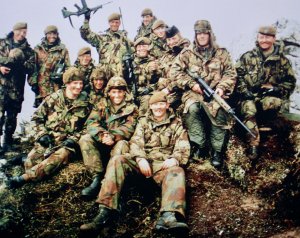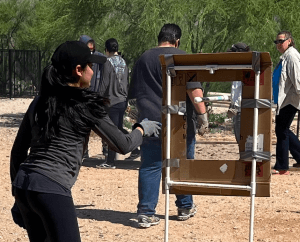Explosive Threats during Casualty Care

This is not a primer on how to treat blast injuries. Rather, it is about the first two phases of TCCC / TECC, Care Under Fire / Direct Threat Care, and Tactical Field Care / Indirect Threat Care, when the Hot / Warm Zone contains explosive threats.
To understand phrases like “Area Denial Attacks,” it would probably help for you to read IEDs: A Different Approach first.
Casualty Care in Area Denial Attacks
If one member of your team was injured by a booby trap IED, count on more being in the area. Remove him or her promptly but don’t drag them out of there without looking where you are going.
Case Study #1 of Area Denial in Patient Care Settings: MASF Tent at Mogadishu Airport
Members of the 187th Aeromedical Evacuation Squadron were assigned to a MASF, Medical Air Staging Facility, at Mogadishu Airport during Operation Gothic Serpent. In those days, a MASF was intended to take pre-stabilized patients and keep them stable till they could be loaded onto aircraft.

During the “Day of the Rangers” Battle of Mogadishu, scores of wounded from the Lost Convoy, unable to drive to their Army field hospital, spilled instead into the MASF at the airport. Fortunately, National Guard medics tend to be paramedics and ER nurses in the civilian world. Between wars, they actually have more gunshot wound experience than regular (full time) military medics.
One of the Rangers, Private Richard Kowalewski, was missing his left forearm and had a huge hole in one side of his flak vest. They already had more than twice the number of critical patients the MASF was set up to handle, and Kowalewski’s vital signs were almost non-existent. They triaged him as “expectant” (likely to die anyway) and focused on the many patients they had some chance of saving.
One fundamental principle of triage is that triage decisions should be periodically re-assessed. When most of the other Rangers, Delta operators, and Somali prisoners from the convoy had been stabilized, they re-checked the expectant patients and found that Private Kowalewski still had a weak, thready pulse. They decided to do what they could for him.
Pulling open his vest, they found an unexploded RPG–rocket propelled grenade–warhead, lodged left-to-right through Kowalewski’s chest. Somehow, they had missed the RPG when what was left of the convoy arrived and they had become inundated in severely wounded patients.
This was a “Cold Zone,” Casualty Collection Point setting. One fundamental principle of TCCC / TECC is that Cold Zones can become Warm or Hot Zones at a moment’s notice (see Cold Zones Aren’t).
Multiple other patients in that MASF tent were barely alive–too unstable to move. While it’s almost never advisable to move UXOs (unexploded ordinance), they decided to remove the patient containing the RPG warhead from the environment, rather than moving the entire MASF facility with all its patients and medical gear to another location.
They gently carried Private Kowalewski out of the tent, as far away from the other patients as possible, and surrounded him with sandbags.
Case Study #2 of Area Denial in Patient Care Settings: Ajax Bay
During the 1982 Falklands / Malvinas campaign, British military medics set up an advanced (meaning forward, not high-tech) surgical center (ASC) in an abandoned meat packing plant at Ajax Bay. With the hilly, boggy ground and lack of infrastructure, usable military real estate of any kind was at a premium. The ASC was located next to an ammunition / supply dump, and not marked with red crosses visible from the air. Argentine Air Force Skyhawks hit the building with four 880 pound bombs (eight other bombs hit the area, killing six, wounding twenty-seven, and causing fires and secondary explosions from the ammo dump).
Of the four bombs that hit the dressing station / ASC, one exploded. One went through the building sideways (the Argentines flew at extremely low level to survive), knocking a hole in the front wall, and continued on to the beach. Two lodged in the ASC building and did not explode (neither did the bomb on the beach). The position of the bombs in the ASC was such that they could not be defused.
Their narrow toe-hold on the fringes of San Carlos Water / Falkland Sound, and the harsh, almost Antarctic conditions of winter at that latitude of the southern hemisphere, dictated that the ASC had to stay in that facility. They rearranged the internal layout of the ASC, contracting and consolidating some areas to maximize distance from the bombs, then continued to do patient care. The doctors, nurses, and medics even slept in the building–mostly for shelter & proximity in case of incoming patient surges, but also to boost patient confidence and morale.
Desperate times, desperate measures.
Some post-surgical patients were evacuated to a hospital ship before they would have been moved from a civilian recovery room. Movement of others was abnormally delayed. Those patient movement decisions had more to do with maximizing the scarce airlift available than with the presence of the unexploded bombs; almost all of the helicopters shipped south for the campaign wound up on the bottom of the Atlantic ocean.

Case Study #3 of Area Denial in Patient Care Settings: Bomb Threat at Cheyenne Regional Medical Center
On 13 Oct 2015, I was doing a ride along with the Cheyenne Police Department when the only major hospital in SE Wyoming got a bomb threat. Although there was also a Veterans Administration hospital in town, the credibility of the threat was not deemed high enough to outweigh the risks of evacuating all the patients to satellite facilities.
I helped search lesser-used areas of the hospital at a furious pace, up to and beyond the deadline the caller stated. I’ve taken a lot of IED recognition courses, and even taught a few, but all of my bomb identification training experience was not worth nearly as much as the nurses’ and med-tech’s intimate knowledge of their environment, and what did or did not belong there.
If your facility ever gets a bomb threat,
the people who work there should search their own work spaces for something out of place.
Just becasue an object is unattended does NOT make is suspcious, in and of itself. There will usually be something about an object nobody claims that will make it seem supicious. If they find a suspicious object, they should:
- Put their cell phone on airplane mode.
- Evacuate any patients in the area.
- Get a zoomed-IN photo of the suspicious object.
- Get a zoomed-OUT photo of the whole area with the object in it, to show responding bomb techs (EOD, explosive ordnance disposal) where it is in the room.
- Take note of the room number and evacuate.
- Actively seek responding EOD and pass on any info they have about the object(s)
Casualty Care when Bombs are Being Tossed
In a Watertown Shootout type situation, if you are treating a casualty when a bomb is tossed at you, your options will depend on how far away the bomb is and the distance to cover from it. They will also depend on how badly injured the casualty is. But in any case, TIME IS YOUR GREATEST ENEMY.
If the IED is some distance away, you may be able to shield the patient’s body.
If there is cover nearby and getting there would NOT expose you to direct fire from the threat, you MAY, possibly, have time to put that between you and the IED.
But moving the bomb is always going to be faster than moving the patient.
If you are treating a patient and a pipe bomb lands in his or her lap, toss that bomb away, NOW!

Worst case scenario, use your trauma shears to cut the burning fuse as close to the bomb as possible.
–George H, TECC / TCCC instructor and former Tac Medic
Selected Sources
Most of this material was originally published in IEDs: A Different Approach, but as the information is somewhat esoteric to the Tactical Medicine world, it was sectioned out and put in the TacMed category. In addition to the sources listed in that primer, the following were used to compile this medical supplement.
Colonel Charles G. Batty, MBE L/RAMC, “Changes in the Care of the Battle Casualty: Lessons Learned from the Falklands Campaign,” Military Medicine, vol. 164, May 1999, pp. 336-40.
Department of Homeland Security & New Mexico Tech Energetic Materials Research & Testing Center, Understanding & Planning for School Bomb Incidents, 2009.
Mark Bowden, Black Hawk Down, A Story of Modern War (New York: Atlantic Monthly Press, 1999), especially pp. 127 – 28. Bill Wise did not mention the name of the soldier who had the unexploded RPG in his chest. Bowden did not mention Private Kowalewski’s Cold Zone medical treatment, or the MASF at Mogadishu Airport, in his excellent book. Other 187 AES personnel in the MASF tent corroborated Wise’s version of events. My friend and former co-worker, Eric Spalding, who was in the truck ahead of Kowalewski’s (and was rammed by it when Kowalewski’s ability to drive was completely compromised), could not corroborate the disposition of Kowalewski’s dying body, as Specialist Spalding was wounded in both legs, and by the time they got around to re-triaging the expectant casualties, the Air Force medics had pumped Eric full of pain killers.
Max Hastings and Simon Jenkins, The Battle for the Falklands (London: WW Norton & Co), 1983.
William Wise, presentation on 187 AES Support of Operation Gothic Serpent, Mogadishu, Somalia, Oct 1993. Cheyenne Municipal Airport, Wyoming. Bill Wise was a very experienced Denver paramedic, who was also an Aeromedical Evacuation Crew Member with the Wyoming Air National Guard. Although MASFs were, at that time, only intended to take pre-stabilized patients, Wise and the others with him could read the writing on the wall. Weeks before the worst fighting, they stockpiled numerous emergency supplies, turning the MASF facility into a de facto emergency room. That wound up saving the lives of many Rangers (and even that of an Army doctor who visited them after the battle to congratulate them, and was subsequently sliced through both femorals by a mortar, right outside the MASF tent–a rare and highly effective use of MAST trousers). After Mogadishu, USAF MASF guidance changed from “stabilizED” to allow “stabilizABLE” patients.
